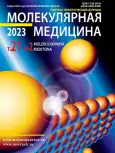Activation of the mapk signal cascade components phosphorylation involved in the formation of the G0-positive tumor phenotype
- Authors: Esimbekova A.R.1, Lapkina E.Z.1, Ruksha T.G.1
-
Affiliations:
- Professor V.F. Voino-Yasenetsky Krasnoyarsk State Medical University
- Issue: Vol 21, No 2 (2023)
- Pages: 33-38
- Section: Original research
- URL: https://journals.eco-vector.com/1728-2918/article/view/340862
- DOI: https://doi.org/10.29296/24999490-2023-02-05
- ID: 340862
Cite item
Abstract
Introduction. Among the heterogeneous population of tumor cells, there are so-called dormant and senescent cells located in the G0 phase of the cell cycle. The transition to the G0 phase is a stress response mediated, for example, by treatment with chemotherapeutic drugs. The functioning of such cells is associated with the development of non-response.
The aim of the study. G0-positive skin melanoma cells modulation with subsequent assessment of the MARK signal cascade molecules, including the main tumor suppressor p53.
Material and methods. Skin melanoma cells were incubated with the cytostatic drug dacarbazine to induce the level of G0-positive cells. Total RNA extracted from cells was used for transcriptome analysis, after which the level of phosphorylation of MARK key molecules was evaluated. By immunocytochemistry (ICC) and real-time PCR (PCR-RT) the activity of tumor suppressor p53 was analyzed.
Results. As a result of the G0-positive cells level modulation, the MARK signal cascade is among the signaling pathways with the largest number of genes with altered expression. Significantly increased the number of phosphorylated proteins JNK, p70S6K, MEK, RSK1 and RSK2, as well as protein p53, capable of forming a senescent phenotype of tumor cells.
Conclusion. When the level of G0-positive skin melanoma cells is modulated by the cytostatic drug dacarbazine, phosphorylation of the MARK signaling cascade components involved in the formation of the G0-positive tumor phenotype increases.
Full Text
About the authors
Aleksandra R. Esimbekova
Professor V.F. Voino-Yasenetsky Krasnoyarsk State Medical University
Author for correspondence.
Email: aleksandra.esimbekova.96@mail.ru
ORCID iD: 0000-0001-6363-5941
PhD student of the Department of Pathophysiology
Russian Federation, P. Zeleznyak street, 1, Krasnoyarsk, 660022Ekaterina Z. Lapkina
Professor V.F. Voino-Yasenetsky Krasnoyarsk State Medical University
Email: e.z.lapkina@mail.ru
ORCID iD: 0000-0002-7226-9565
Associate Professor of the Department of Pharmacy, Candidate of biological sciences
Russian Federation, P. Zeleznyak street, 1, Krasnoyarsk, 660022Tatiana G. Ruksha
Professor V.F. Voino-Yasenetsky Krasnoyarsk State Medical University
Email: tatyana_ruksha@mail.ru
ORCID iD: 0000-0001-8142-4283
Head of the Department of Pathophysiology, Doctor of medical sciences, Professor
Russian Federation, P. Zeleznyak street, 1, Krasnoyarsk, 660022References
- Rezatabar S., Karimian A., Rameshknia V., Parsian H, Majidinia M., Kopi T.A., Bishayee A., Sadeghinia A., Yousefi M., Monirialamdari M., Yousefi B. RAS/MAPK signaling functions in oxidative stress, DNA damage response and cancer progression. J. Cell Physiol. 2019; 234 (9): 14951–65. doi: 10.1002/jcp.28334.
- Oeztuerk-Winder F., Ventura J.J. The many faces of p38 mitogen-activated protein kinase in progenitor/stem cell differentiation. Biochem J. 2012; 445 (1): 1–10. doi: 10.1042/BJ20120401.
- Vallette F.M., Olivier C., Lézot F., Oliver L., Cochonneau D., Lalier L., Cartron P.F., Heymann D. Dormant, quiescent, tolerant and persister cells: Four synonyms for the same target in cancer. Biochem Pharmacol. 2019; 162: 169–76. doi: 10.1016/j.bcp.2018.11.004.
- Senft D., Ronai Z.A. UPR, autophagy, and mitochondria crosstalk underlies the ER stress response. Trends Biochem Sci. 2015; 40 (3): 141–8. doi: 10.1016/j.tibs.2015.01.002.
- Pranzini E., Raugei G., Taddei M.L. Metabolic Features of Tumor Dormancy: Possible Therapeutic Strategies. Cancers (Basel). 2022; 14 (3): 547. doi: 10.3390/cancers14030547.
- Lapkina E.Z., Esimbekova A.R., Beleniuk V.D., Savchenko A.A., Ruksha T.G. Cell cycle phase distribution in B16 melanoma cells under dacarbazine treatment. Cell and Tissue Biology. 2022; 64 (6): 573–80. doi: 10.31857/S0041377122060074
- Gutierrez G.J., Tsuji T., Cross J.V., Davis R.J., Templeton D.J., Jiang W., Ronai Z.A. JNK-mediated phosphorylation of Cdc25C regulates cell cycle entry and G(2)/M DNA damage checkpoint. J. Biol. Chem. 2010; 285 (19): 14217–28. doi: 10.1074/jbc.M110.121848
- Knievel J., Schulz W.A., Greife A., Hader C., Lübke T., Schmitz I., Albers P., Niegisch G. Multiple mechanisms mediate resistance to sorafenib in urothelial cancer. Int J. Mol. Sci. 2014; 15 (11): 20500–17. doi: 10.3390/ijms151120500.
- Wright E.B., Fukuda S., Li M., Li Y., O’Doherty G.A., Lannigan D.A. Identifying requirements for RSK2 specific inhibitors. J. Enzyme Inhib Med Chem. 2021; 36 (1): 1798–809. doi: 10.1080/14756366.2021.1957862
- Ray-David H., Romeo Y., Lavoie G., Déléris P., Tcherkezian J., Galan J.A., Roux P.P. RSK promotes G2 DNA damage checkpoint silencing and participates in melanoma chemoresistance. Oncogene. 2013; 32 (38): 4480–9. doi: 10.1038/onc.2012.472.
- Ferrari S. A rapid purification protocol for the mitogen-activated p70 S6 kinase Protein Expr Purif. 1998; 13 (2): 170–6. doi: 10.1006/prep.1998.0881
- Schmidt F., Efferth T. Tumor Heterogeneity, Single-Cell Sequencing, and Drug Resistance. Pharmaceuticals (Basel). 2016; 9 (2): 33. doi: 10.3390/ph9020033.
- Chen L., Xu B., Liu L., Liu C., Luo Y., Chen X., Barzegar M., Chung J., Huang S. Both mTORC1 and mTORC2 are involved in the regulation of cell adhesion. Oncotarget. 2015; 6 (9): 7136–50. doi: 10.18632/oncotarget.3044.
- Esimbekova A.R., Palkina N.V., Zinchenko I.S., Belenyuk V.D., Savchenko A.A., Sergeeva E.Y., Ruksha T.G. Focal adhesion alterations in G0-positive melanoma cells. Cancer Med. 2022; 12: 7294-7308. doi: 10.1002/cam4.5510
- Sun X., Shi B., Zheng H., Min L., Yang J., Li X., Liao X., Huang W., Zhang M., Xu S., Zhu Z., Cui H., Liu X. Senescence-associated secretory factors induced by cisplatin in melanoma cells promote non-senescent melanoma cell growth through activation of the ERK1/2-RSK1 pathway. Cell Death Dis. 2018; 9 (3): 260. doi: 10.1038/s41419-018-0303-9.
- Yu Z., Ruter D.L., Kushner E.J., Bautch V.L. Excess centrosomes induce p53-dependent senescence without DNA damage in endothelial cells. FASEB J. 2017; 31 (10): 4295–304. doi: 10.1096/fj.201601320R.
- Cuollo L., Antonangeli F., Santoni A., Soriani A. The Senescence-Associated Secretory Phenotype (SASP) in the Challenging Future of Cancer Therapy and Age-Related Diseases. Biology (Basel). 2020; 9 (12): 485. doi: 10.3390/biology9120485.
Supplementary files









